Climbing Meets Art at Sedona’s Cathedral Rock

Jeremy Collins is something of a dirtbag Renaissance man. He’s put up bold in his home crag, northern Arkansas’ Sam’s Throne. He wrote and illustrated the award-winning book , an ode to five years of exploration in locations leading all four cardinal directions from his home—to Yosemite, China, Canada, and Venezuela. And he started the clothing brand , which produces tees, journals, and prints emblazoned with his designs. When the opportunity arose earlier this month to create an art installation in the shadow of Sedona’s Cathedral Rock—and later climb the classic desert tower—he jumped.
Just a week removed from a stint working on a documentary in the Gorkha District of Nepal, Collins hopped a flight from his home in Kansas City, Missouri, to Sedona, Arizona. He didn’t have a plan when the plane touched down in the red sandstone of Arizona, relying instead on 20 years of experience climbing, camping, and exploring in the desert. Eight hours and about as many cans of spray paint later, he walked away from his “wall of windows,” a mixed-media reflection of the area’s colors and character, and stepped into a climbing harness. “I spent a day creating art from afar and then a day engaging with the landscapes,” he said. “Ultimately, it all came together in one piece and one voice.”
captured the project’s progress.
Photo: , a new winery based in California, footed the bill for the project but let Collins decide where to stage the installation. “Sedona was the first place that popped into mind,” he says, adding that he had never climbed or drawn on location in the area. “The desert is very special to me as a climber and an artist.”
![Collins usually works out of a sketchbook, the obvious choice for squeezing into a suitcase or climbing pack. But for this project, he wanted to do something a little grander. “The idea with the windows [set in front of Cathedral Rock] was to find something that already had a story and bring new life into it,” he says.](https://cdn.outsideonline.com/wp-content/uploads/2015/12/28/window-construction-perspective-sedona.jpg?width=500&enable=upscale)
Collins usually works out of a sketchbook, the obvious choice for squeezing into a suitcase or climbing pack. But for this project, he wanted to do something a little grander. “The idea with the windows [set in front of Cathedral Rock] was to find something that already had a story and bring new life into it,” he says.
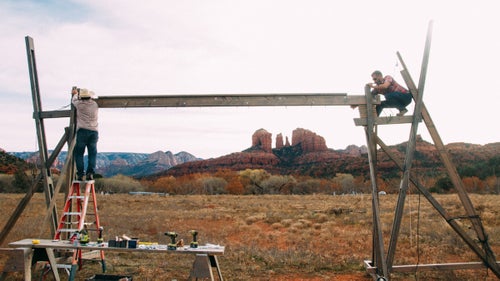
Collins and a local contractor built a structure that stands 20-feet wide by 12-feet tall, on which they hung windows collected from the Habitat for Humanity Restore and through Craigslist. “I’m looking through the windows into the Sedona desert, so these beautiful towers are not only beyond the art, but are part of the art.”
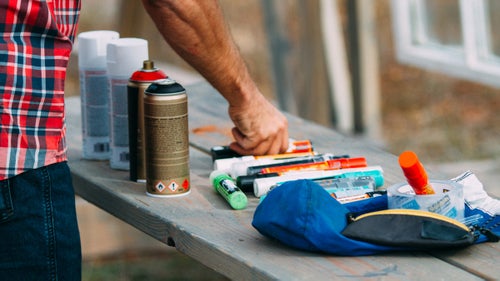
Collins used street art materials to paint on the glass: spray paints and acrylic markers.
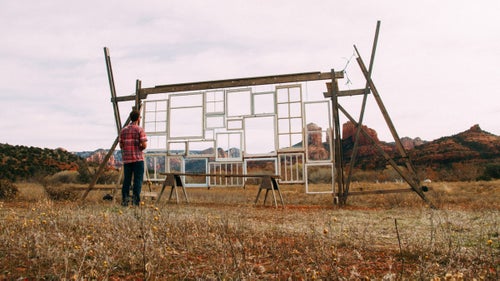
Collins has always considered his climbing and his art reciprocal, feeding off one another. “I wouldn’t want to give up climbing to just be an artist, and I wouldn’t want to give up my art just to be a climber,” he says “The art is informed by the time I spend out having those immersive experiences in the mountains.”
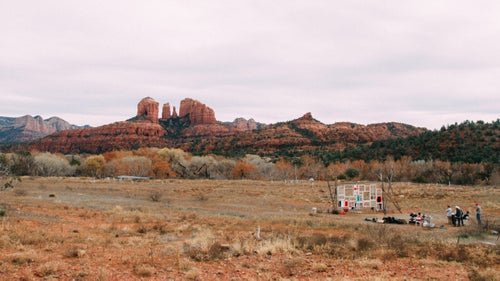
Collins considers the setting where he paints crucial to the outcome: “Whether the art that I create is quality or not generally revolves around how much time I’m spending out in nature.”
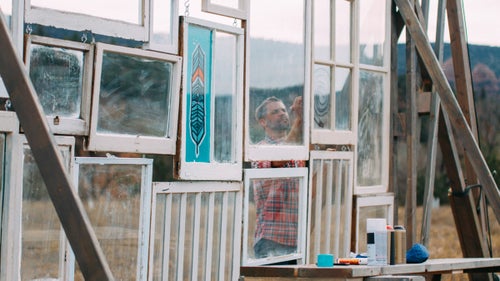
Collins started around 9 a.m. and finished just after sunset, stopping only for a “three minute break to shove some lunch in my belly.”
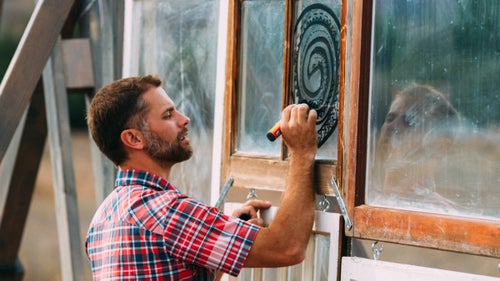
He didn’t sketch out the designs beforehand, instead letting the setting provide the inspiration. “It was pretty much a stream of thought,” he says. “I didn’t have it planned out like, ‘hand goes here, hammer goes here, coyote goes here’… It was very much an immersive, organic experience, coming from all the years that I’ve spent in the desert.”
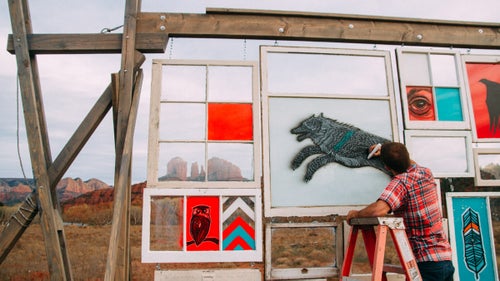
Each image—owl, feather, coyote—symbolizes a larger theme. “When I approached the canvas to start working, the very first thing I heard as I started working was a pack of coyotes in the distance, and I started thinking about my childhood in the Midwest and going on camping trips and hearing coyotes,” Collins says. “It ignites this fear of being out in the wilderness, but also this curiosity.”
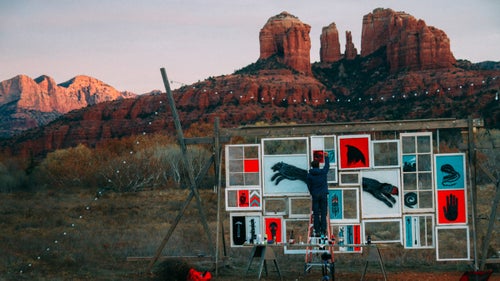
As the sun started to set on the desert, Collins raced to finish his painting in the fading light. He dubbed the structure Hunter, an ode to “my hunt for wilderness, purpose, and adventure, and how the desert has always provided quite a bit of that for me.”